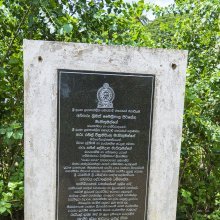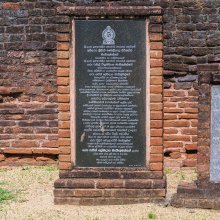Amatya, Amātya, Āmātya: 20 definitions
Introduction:
Amatya means something in Buddhism, Pali, Hinduism, Sanskrit, the history of ancient India, Marathi, Hindi. If you want to know the exact meaning, history, etymology or English translation of this term then check out the descriptions on this page. Add your comment or reference to a book if you want to contribute to this summary article.
Alternative spellings of this word include Amaty.
Images (photo gallery)
In Hinduism
Dharmashastra (religious law)
Source: Wisdom Library: Dharma-śāstraAmātya (अमात्य) refers to “councelor”, to be elected by the king. They should possess the qualities like purity, intelligence, affluence in wealth, well tested virtues and comprehensive. It is used throughout Dharmaśāstra literature such as the Manusmṛti and the Baudhāyana-dharmasūtra.

Dharmashastra (धर्मशास्त्र, dharmaśāstra) contains the instructions (shastra) regarding religious conduct of livelihood (dharma), ceremonies, jurisprudence (study of law) and more. It is categorized as smriti, an important and authoritative selection of books dealing with the Hindu lifestyle.
Purana and Itihasa (epic history)
Source: Cologne Digital Sanskrit Dictionaries: The Purana IndexAmātya (अमात्य).—Their irritation against king, a cause of internal dissensions; to be banished after being deprived of possession, for doing wrongs: Residence of.*
- * Matsya-purāṇa 223. 9; 227. 160; 254. 21-22.

The Purana (पुराण, purāṇas) refers to Sanskrit literature preserving ancient India’s vast cultural history, including historical legends, religious ceremonies, various arts and sciences. The eighteen mahapuranas total over 400,000 shlokas (metrical couplets) and date to at least several centuries BCE.
Natyashastra (theatrics and dramaturgy)
Source: Wisdom Library: Nāṭya-śāstra1) Amātya (अमात्य, “councillor”) refers to a specific “mode of address” (nāman) used in drama (nāṭya), according to Nāṭyaśāstra chapter 19. Amātya is used by Brahmins to address ministers. A similair address in this situation would be Saciva.
2) Amātya (अमात्य) refers to “ministers” (of the king), and their beard (śmaśru) should be represented as white (śveta), according to Nāṭyaśāstra chapter 23. Providing the beard is a component of nepathya (costumes and make-up) and is to be done in accordance with the science of āhāryābhinaya (extraneous representation).
3) Amātya (अमात्य, “secretary”) or Saciva refers to a classification of persons who “move about in public”, according to the Nāṭyaśāstra chapter 34. Accordingly, “Those who are intelligent, versed in polity, powerful, sweet-tongued, conversant with the Arthasāstra, and attached to the subjects and are followers of Dharma, should be always appointed by kings as secretaries (amātya)”.
Note: Saciva as well as amātya originally meant secretary. Amātya also has been used before to indicate a minister. But Arthaśāstra. (1.8.9) distinguishes between amātya and mantrin. Kāmandakīya Nītisāra (VIII.1) also does the same. According to the latter amātya seems to be identical with saciva (see IV. 25, 30, 31). According to Śukranīti saciva, amātya and mantrin are three different functionaries (See II. 94, 95 and 103). The Rudradāman inscription seems to distinguish between mantrin and saciva.
According to the Nāṭyaśāstra chapter 35, the role (bhūmikā) of actors playing amātyas (secretaries) is defined as, “Persons who have well-formed limbs, distinct speech, are neither tall nor fat, are heroic, have reasoning positive and negative, are brave, and eloquent and have presence of mind, should be employed to take up the role of army-leaders (senāpati) and secretaries (amātya)”.

Natyashastra (नाट्यशास्त्र, nāṭyaśāstra) refers to both the ancient Indian tradition (shastra) of performing arts, (natya—theatrics, drama, dance, music), as well as the name of a Sanskrit work dealing with these subjects. It also teaches the rules for composing Dramatic plays (nataka), construction and performance of Theater, and Poetic works (kavya).
Arthashastra (politics and welfare)
Source: Shodhganga: Kakati Ganapatideva and his times (artha)Amātya (अमात्य) may refer to the provincial governor like Allumprolarāja of Manthena epigraph dated A.D. 1199, who was the lord of Cennūrudeśa. In Konatmakur epigraph dated A.D. 1251, Dāmaya was mentioned as both amātya and mantri. It seems that amātya and mantri may be hereditary titles or suffixes.

Arthashastra (अर्थशास्त्र, arthaśāstra) literature concerns itself with the teachings (shastra) of economic prosperity (artha) statecraft, politics and military tactics. The term arthashastra refers to both the name of these scientific teachings, as well as the name of a Sanskrit work included in such literature. This book was written (3rd century BCE) by by Kautilya, who flourished in the 4th century BCE.
Jyotisha (astronomy and astrology)
Source: Wisdom Library: Brihat Samhita by VarahamihiraAmātya (अमात्य) refers to “ministers”, according to the Bṛhatsaṃhitā (chapter 5), an encyclopedic Sanskrit work written by Varāhamihira mainly focusing on the science of ancient Indian astronomy astronomy (Jyotiṣa).—Accordingly, “If the sun and moon should begin to be eclipsed when only half risen, deceitful men will suffer as well as sacrificial rites. [...] If when in mid-heaven, the central provinces will suffer, but there will be happiness over the land and the price of food grains will fall. If when in the fifth section, herbivorous animals, ministers [i.e., amātya] and household inmates will suffer as also the Vaiśyas. If they should be eclipsed when in the sixth section of the firmament, women and the Śūdras will suffer; if when setting, robbers and the border Mlecchas will perish. Those will be happy in whose section the eclipse terminates”.

Jyotisha (ज्योतिष, jyotiṣa or jyotish) refers to ‘astronomy’ or “Vedic astrology” and represents the fifth of the six Vedangas (additional sciences to be studied along with the Vedas). Jyotisha concerns itself with the study and prediction of the movements of celestial bodies, in order to calculate the auspicious time for rituals and ceremonies.
In Buddhism
Mahayana (major branch of Buddhism)
Source: De Gruyter: A Buddhist Ritual Manual on AgricultureAmātya (अमात्य) refers to the “chief ministers”, according to the Vajratuṇḍasamayakalparāja, an ancient Buddhist ritual manual on agriculture from the 5th-century (or earlier), containing various instructions for the Sangha to provide agriculture-related services to laypeople including rain-making, weather control and crop protection.—Accordingly, [after the Bhagavān taught the great heart-dhāraṇī], “[...] O Serpent chiefs, merely upon calling to mind, all Nāga rulers along with their sons, wives, chief ministers (sa-amātya) and retinues [shall ward off] venomous snakes, cold spells, clouds, winds and clouds entirely by the authorization of the Tathāgata’s word, with the empowerment of the vow of the Tathāgatas. [...]”.

Mahayana (महायान, mahāyāna) is a major branch of Buddhism focusing on the path of a Bodhisattva (spiritual aspirants/ enlightened beings). Extant literature is vast and primarely composed in the Sanskrit language. There are many sūtras of which some of the earliest are the various Prajñāpāramitā sūtras.
India history and geography
Source: Cologne Digital Sanskrit Dictionaries: Indian Epigraphical GlossaryAmātya.—(IE 8-3; EI 28, 30; CII 3, 4; BL; HD; LL), a minister; sometimes, officer in charge of a district; explained as deś-ādi-kārya-nirvāhaka; in some cases, called Sarvādhikārin, etc., additionally. Cf. Hist. Dharm., Vol. III, p. 114, note 150. See Mahāmātya. Note: amātya is defined in the “Indian epigraphical glossary” as it can be found on ancient inscriptions commonly written in Sanskrit, Prakrit or Dravidian languages.

The history of India traces the identification of countries, villages, towns and other regions of India, as well as mythology, zoology, royal dynasties, rulers, tribes, local festivities and traditions and regional languages. Ancient India enjoyed religious freedom and encourages the path of Dharma, a concept common to Buddhism, Hinduism, and Jainism.
Languages of India and abroad
Marathi-English dictionary
Source: DDSA: The Molesworth Marathi and English Dictionaryamātya (अमात्य).—m (S) A minister one of the aṣṭapradhāna q. v., attendant upon a king. 2 A minister or counsellor gen.
Source: DDSA: The Aryabhusan school dictionary, Marathi-Englishamātya (अमात्य).—m A minister.
Marathi is an Indo-European language having over 70 million native speakers people in (predominantly) Maharashtra India. Marathi, like many other Indo-Aryan languages, evolved from early forms of Prakrit, which itself is a subset of Sanskrit, one of the most ancient languages of the world.
Sanskrit dictionary
Source: DDSA: The practical Sanskrit-English dictionaryAmātya (अमात्य).—[amā saha vasati, amā-tyap, avyayāttyap P. IV. 2.14. Vārt. amehakvatasitrebhya eva]
1) One living with or near another, an inmate of the same house or family (Ved.).
2) A companion or follower of a king, minister; तस्यामात्या गुणैरासन्निक्ष्वाकोः सुमहात्मनः (tasyāmātyā guṇairāsannikṣvākoḥ sumahātmanaḥ) Rām.1.7.1; अमात्याः सर्व एवैते कार्याः स्युर्न तु मन्त्रिणः (amātyāḥ sarva evaite kāryāḥ syurna tu mantriṇaḥ) Kau. A.1.8.
-amātyikā f. M. Bh. on P.VII.3.1.
Derivable forms: amātyaḥ (अमात्यः).
--- OR ---
Āmātya (आमात्य).—[amātya eva svārthe aṇ]
1) A minister, counsellor.
2) A general; see अमात्य (amātya)
Derivable forms: āmātyaḥ (आमात्यः).
Source: Cologne Digital Sanskrit Dictionaries: Shabda-Sagara Sanskrit-English DictionaryAmātya (अमात्य).—m.
(-tyaḥ) A minister, a counsellor. E. amā near, tyap aff.
--- OR ---
Āmātya (आमात्य).—m.
(-tyaḥ) 1. A minister, a counseller, an advicer. 2. A general. E. See amātya.
Source: Cologne Digital Sanskrit Dictionaries: Benfey Sanskrit-English DictionaryAmātya (अमात्य).—[amā + tya] (the basis signifies in the Vedas ‘in the house’). I. adj. Being in the house. Ii. m. (A companion of the king) A minister, [Rājataraṅgiṇī] 5, 3.
Source: Cologne Digital Sanskrit Dictionaries: Cappeller Sanskrit-English DictionaryAmātya (अमात्य).—[masculine] inmate, relative, householder, councillor of a king, minister.
Source: Cologne Digital Sanskrit Dictionaries: Monier-Williams Sanskrit-English Dictionary1) Amatyā (अमत्या):—[=a-matyā] [from a-mati > a-mata] ind. [instrumental case] unconsciously, [Manu-smṛti iv, 222 and v, 20; Gautama-dharma-śāstra]
2) Amātya (अमात्य):—[from amā] a m. (4) ([from] 1. amā cf. [Pāṇini 4-2, 104 [Scholiast or Commentator]]) inmate of the same house, belonging to the same house or family, [Ṛg-veda vii, 15, 3; Vājasaneyi-saṃhitā; Āśvalāyana-gṛhya-sūtra; Kātyāyana-śrauta-sūtra]
3) [v.s. ...] ‘a companion (of a king)’, minister, [Mahābhārata; Manu-smṛti etc.]
4) b See 1. amā
5) Āmātya (आमात्य):—m. (= amātya q.v.), a minister, counsellor, [cf. Lexicographers, esp. such as amarasiṃha, halāyudha, hemacandra, etc.]
Source: Cologne Digital Sanskrit Dictionaries: Yates Sanskrit-English Dictionary1) Amātya (अमात्य):—[amā+tya] (tyaḥ) 1. m. Minister of state.
2) Āmātya (आमात्य):—(tyaḥ) 1. m. A counsellor.
Source: DDSA: Paia-sadda-mahannavo; a comprehensive Prakrit Hindi dictionary (S)Amātya (अमात्य) in the Sanskrit language is related to the Prakrit word: Amacca.
[Sanskrit to German]
Sanskrit, also spelled संस्कृतम् (saṃskṛtam), is an ancient language of India commonly seen as the grandmother of the Indo-European language family (even English!). Closely allied with Prakrit and Pali, Sanskrit is more exhaustive in both grammar and terms and has the most extensive collection of literature in the world, greatly surpassing its sister-languages Greek and Latin.
Hindi dictionary
Source: DDSA: A practical Hindi-English dictionaryAmātya (अमात्य) [Also spelled amaty]:—(nm) a minister.
...
Kannada-English dictionary
Source: Alar: Kannada-English corpusAmātya (ಅಮಾತ್ಯ):—[noun] a person appointed by the head of a government to take charge of some department; a minister.
--- OR ---
Āmātya (ಆಮಾತ್ಯ):—[noun] a minister a) a man acting for another as agent and carrying out given orders or designs; b) a man appointed by the head of a government to take charge of some department or whose profession is to advise the state-head in matters of administration.
Kannada is a Dravidian language (as opposed to the Indo-European language family) mainly spoken in the southwestern region of India.
See also (Relevant definitions)
Starts with: Amatya-sabha, Amatyaprekshita, Amatyotpatti.
Ends with (+9): Aikamatya, Aikyamatya, Anaikamatya, Avamatya, Bhamatya, Bhanamatya, Decayamatya, Duramatya, Ekamatya, Hritapragraha-amatya, Kaditamatya, Khamatya, Kumaramatya, Kumarapadiya-amatya, Mahakumaramatya, Mahamatya, Mahamudra-amatya, Pradhanamatya, Puja-amatya, Rajamatya.
Full-text (+45): Amacca, Mahamatya, Kumarapadiya-amatya, Vishay-amatya, Kumaramatya, Pradhanamatya, Samatya, Ashtapradhana, Puja-amatya, Satyasainika, Amatya-sabha, Bahugraha, Rajjugrahaka-amatya, Amatyotpatti, Saciva, Parshadya, Mahamudra-amatya, Kaditamatya, Rajamatya, Sapta-amatya.
Relevant text
Search found 26 books and stories containing Amatya, A-matya, A-matyā, Amātya, Āmātya, Amatyā; (plurals include: Amatyas, matyas, matyās, Amātyas, Āmātyas, Amatyās). You can also click to the full overview containing English textual excerpts. Below are direct links for the most relevant articles:
Amarakoshodghatana of Kshirasvamin (study) (by A. Yamuna Devi)
Politics and Administration (1): The State requisites of regal administration < [Chapter 3 - Social Aspects]
Politics and Administration (5): Law and Administration < [Chapter 3 - Social Aspects]
Shishupala-vadha (Study) (by Shila Chakraborty)
Amātya according to Kauṭilya < [Chapter 2b - Activities of Minister (Amātya)]
Introduction < [Introduction]
Rig Veda (translation and commentary) (by H. H. Wilson)
The Matsya Purana (critical study) (by Kushal Kalita)
Part 5 - The king and his Council (pariṣad) < [Chapter 6 - Polity in the Matsyapurāṇa]
Part 6 - Qualifications of Ministers (amātya) < [Chapter 6 - Polity in the Matsyapurāṇa]
Part 2 - The components of the State (the saptāṅga theory) < [Chapter 6 - Polity in the Matsyapurāṇa]
Harshacharita (socio-cultural Study) (by Mrs. Nandita Sarmah)
Part 2.3: Relation between the King and the Ministers < [Chapter 5 - Political Aspects]
Part 3: Other Office Bearers of the Government < [Chapter 5 - Political Aspects]
Manusmriti with the Commentary of Medhatithi (by Ganganatha Jha)
Verse 9.234 < [Section XXXI - Miscellaneous Punishments]
Related products


